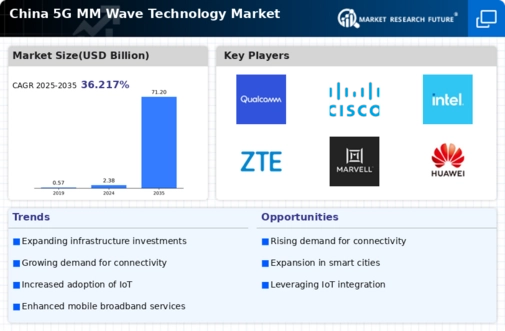Expansion of Smart Cities
The development of smart cities in China is significantly influencing the 5g mm-wave-technology market. As urban areas evolve into interconnected ecosystems, the demand for high-speed, low-latency communication becomes critical. The integration of mm-wave technology facilitates real-time data exchange, essential for smart transportation, energy management, and public safety systems. By 2025, it is anticipated that over 100 cities in China will implement smart city initiatives, driving the need for advanced communication technologies. Consequently, the 5g mm-wave-technology market stands to gain from this urban transformation.
Government Initiatives and Support
The Chinese government plays a pivotal role in the advancement of the 5g mm-wave-technology market. With initiatives aimed at fostering innovation and technological development, the government has allocated substantial funding to support research and infrastructure development. In 2025, government investments in 5g infrastructure are projected to exceed $50 billion, reflecting a commitment to establishing a robust telecommunications framework. This support not only accelerates the deployment of mm-wave technology but also encourages private sector participation, thereby enhancing the overall growth of the 5g mm-wave-technology market.
Growth of the Internet of Things (IoT)
The proliferation of IoT devices in China is a key driver for the 5g mm-wave-technology market. With millions of devices expected to be connected by 2025, the demand for high-capacity networks is paramount. The mm-wave spectrum offers the bandwidth necessary to support the vast number of devices and the data they generate. It is estimated that the number of IoT connections in China will reach 1.5 billion by 2025, creating a substantial market opportunity for the 5g mm-wave-technology market. This growth underscores the importance of robust communication infrastructure to accommodate the expanding IoT landscape.
Rising Demand for High-Speed Connectivity
The 5g mm-wave-technology market in China is experiencing a surge in demand for high-speed connectivity. As urbanization accelerates, the need for faster internet services becomes paramount. This demand is driven by the proliferation of smart devices and the increasing reliance on data-intensive applications. In 2025, it is estimated that mobile data traffic in China will reach approximately 200 exabytes per month, necessitating advanced technologies like mm-wave to support this growth. The 5g mm-wave-technology market is thus positioned to benefit from this trend, as consumers and businesses alike seek enhanced connectivity solutions.
Advancements in Telecommunications Technology
Technological advancements in telecommunications are propelling the 5g mm-wave-technology market forward. Innovations in antenna design, signal processing, and network architecture are enhancing the efficiency and effectiveness of mm-wave technology. These advancements enable higher data rates and improved coverage, which are essential for meeting the demands of modern communication. In 2025, the market is expected to witness a 30% increase in the deployment of mm-wave technology, driven by these technological improvements. The 5g mm-wave-technology market is thus poised for substantial growth as these innovations continue to unfold.

















Leave a Comment